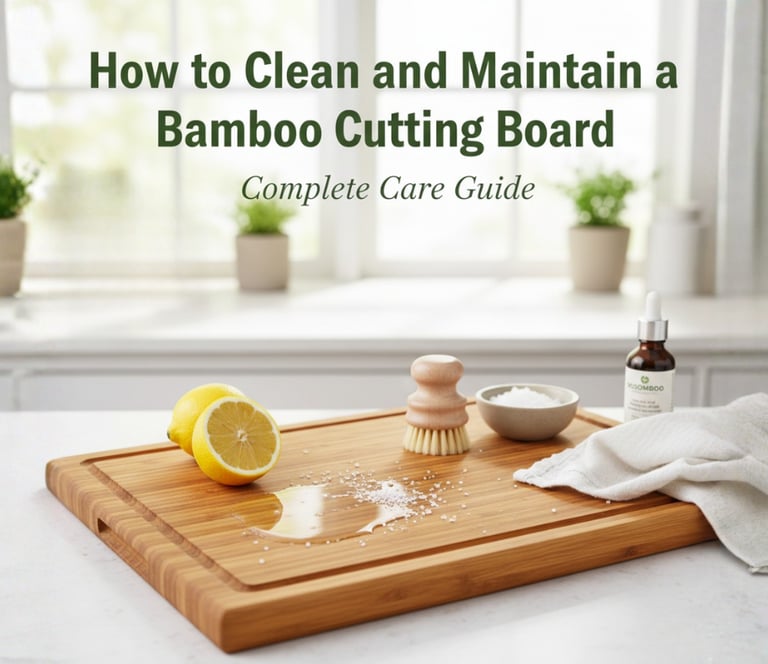How to Clean and Maintain a Bamboo Cutting Board: Complete Care Guide
Wondering how to clean and maintain your bamboo cutting board the right way? Whether you’ve just bought a new one or use it daily, proper care prevents cracking, warping, and stains—helping your board last for years. This complete 2025 care guide explains the best way to clean, dry, oil, and store bamboo cutting boards for long-term durability and freshness.
CUTTING BOARD
Naimul
11/11/20253 min read


How to Clean and Maintain a Bamboo Cutting Board: Complete Care Guide for 2025
A bamboo cutting board isn’t just a kitchen essential—it’s a statement of natural beauty, sustainability, and craftsmanship. But to keep that smooth finish and durability for years, it requires special care. In this guide, we’ll show you how to properly clean, oil, and maintain your bamboo cutting board so it stays hygienic, long-lasting, and elegant in your kitchen.
Why Bamboo Cutting Boards Need Special Care
Bamboo cutting boards are eco-friendly, durable, and gentle on knives—but they’re also sensitive to moisture and heat. Unlike plastic or glass boards, bamboo is made of compressed natural fibers that can swell or crack when soaked or exposed to harsh cleaning. Regular maintenance helps preserve the surface, prevents bacteria buildup, and keeps the board looking brand new.
Daily Cleaning Steps
Rinse Immediately After Use
Always rinse your bamboo cutting board right after chopping fruits, vegetables, or meats. Use warm water and a mild dish soap to remove food particles and prevent stains or lingering smells.
Avoid Soaking in Water
Never soak your bamboo cutting board in water or place it in the dishwasher. Prolonged water exposure can weaken the bamboo fibers, cause warping, or split the seams.
Drying Properly
After rinsing, towel dry immediately and stand the board upright to let air circulate. Proper airflow helps prevent mold and extends the lifespan of your board.
Deep Cleaning and Deodorizing
For deep cleaning or odor removal, sprinkle coarse salt over the board and scrub it with half a lemon. Rinse and dry thoroughly.
You can also use diluted white vinegar for sanitizing—perfect for removing strong smells from garlic or onions. For stubborn stains, lightly sand the surface before re-oiling.
Oiling Your Bamboo Cutting Board
Oiling keeps your bamboo board hydrated, smooth, and protected from cracking. Use food-grade mineral oil or bamboo board conditioner once a month (or every 2–3 weeks in dry climates).
Steps to oil your board:
Clean and dry the board completely.
Apply a small amount of mineral oil on all sides.
Rub in using a clean cloth and let it absorb overnight.
Wipe off any excess before use.
Regular oiling maintains that fresh, rich bamboo look and prevents surface dullness.
Common Mistakes to Avoid
❌ Putting the board in the dishwasher
❌ Soaking it in water
❌ Using cooking oils like olive or vegetable oil (they turn rancid)
❌ Leaving it flat to dry
❌ Ignoring deep cuts or cracks that can trap bacteria
Storage and Long-Term Maintenance
Store your bamboo cutting board upright in a cool, dry area. Avoid direct sunlight or placing it near heat sources.
If you cook frequently, rotate between two boards so each one gets enough time to dry properly. After heavy use, deep clean and re-oil to restore its finish.
When to Replace a Bamboo Cutting Board
Replace your board if you notice:
Deep grooves that trap food or bacteria
Cracks or splits along the edges
Warping or uneven surfaces
Persistent odors even after cleaning
At this stage, it’s safer and more hygienic to invest in a new board.
✨ Upgrade your kitchen with our Smart Bamboo Cutting Board Set — designed for durability, functionality, and modern style.
Conclusion
A well-maintained bamboo cutting board adds elegance and eco-friendly value to your kitchen. With simple steps like daily cleaning, proper drying, and monthly oiling, you can enjoy years of use without cracks or stains. Take care of your board—and it will take care of your meals.
FAQ
Q1: Can I put my bamboo cutting board in the dishwasher?
No. The heat and water pressure can warp or crack bamboo. Always hand wash.
Q2: How often should I oil my bamboo cutting board?
At least once a month, or more frequently if the board looks dry.
Q3: What kind of oil is best?
Use food-grade mineral oil or a bamboo conditioner. Avoid olive or vegetable oils.
Q4: How do I remove garlic or onion smells?
Scrub with lemon and coarse salt, then rinse and dry.
Q5: Why is my board splitting?
Overexposure to water or lack of oiling causes bamboo to dry out and crack. Follow the care routine to avoid it.
MOSOMBOO
© Copyright Mosomboo 2022 - 2025. Site Built and Managed by IntelliPath
Follow us on Social
CATEGORIES
MENU
INFO
